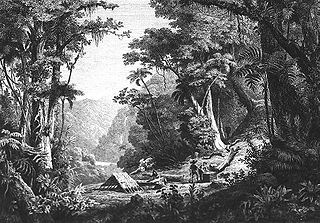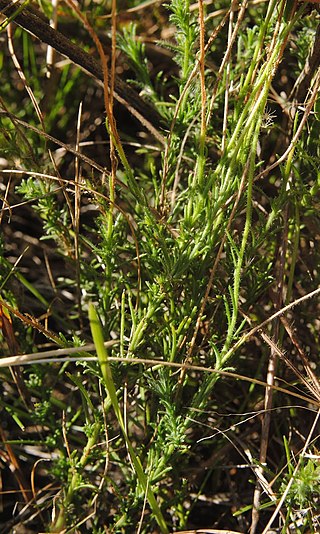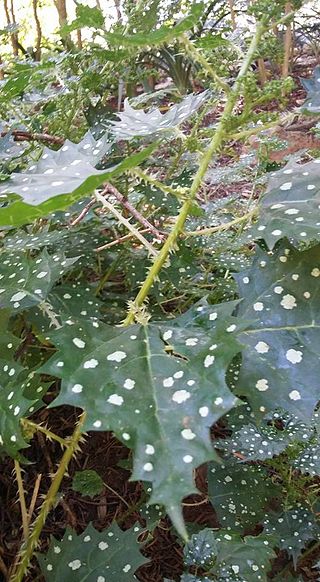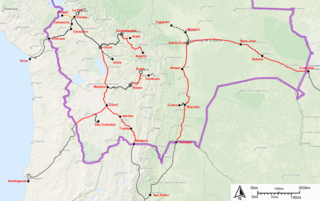
The vicuña or vicuna is one of the two wild South American camelids, which live in the high alpine areas of the Andes, the other being the guanaco, which lives at lower elevations. Vicuñas are relatives of the llama, and are now believed to be the wild ancestor of domesticated alpacas, which are raised for their coats. Vicuñas produce small amounts of extremely fine wool, which is very expensive because the animal can only be shorn every three years and has to be caught from the wild. When knitted together, the product of the vicuña's wool is very soft and warm. The Inca valued vicuñas highly for their wool, and it was against the law for anyone but royalty to wear vicuña garments; today, the vicuña is the national animal of Peru and appears on the Peruvian coat of arms.

Hugh Algernon Weddell was a physician and botanist, specialising in South American flora.
Aphanactis is a genus of flowering plants in the family Asteraceae.

Laportea is a genus of plants in the family Urticaceae. They are herbaceous, either annual or perennial. Like many plants of the Urticaceae, they have stinging hairs. There are stinging and non-stinging hairs on the same plant. The genus was named after the French naturalist Francis de Laporte de Castelnau.

This is a record of Peru's results at the Copa América. Ever since their first Copa América, Peru has had good showings. It is often remembered by fans that Peru was the fourth team to win the South American cup. Even though in 1939 Peru played against only 5 of the South American nations, in 1975 Peru won the cup once more.

Hysterionica is a genus of flowering plants in the family Asteraceae.

Hyaloseris is a genus of South American flowering plants in the family Asteraceae.
Chiliotrichiopsis is a genus of flowering plants in the family Asteraceae. It is native to the Andes, where it is distributed in Peru, Bolivia, and Argentina. Species occur in the mountains up to 4200 meters in elevation.
Chrysactinium is a genus of South American flowering plants in the family Asteraceae.

The second constituency for French residents overseas is one of eleven constituencies representing French citizens living abroad. It was created by the 2010 redistricting of French legislative constituencies and elects, since 2012, one representative to the National Assembly.

José Félix Esquivel y Aldao was an Argentine Dominican friar and soldier who became a general and then the undisputed Federalist caudillo of Mendoza Province. His ability as a warrior and his brutality became legendary. The largely fictionalized biography that Domingo Faustino Sarmiento wrote fed his legend. An effective ruler, he did much for his province, but was also one of the cruelest federalist leaders.

Leucostele terscheckii, commonly known as the cardon grande cactus or Argentine saguaro, is a large cactus native to South America and popular in cultivation.

Gamochaeta is a genus of flowering plants in the family Asteraceae. There has not always been agreement among botanists regarding its status as a recognized genus, but it has become more accepted in recent years. It currently includes many plants that previously belonged in genus Gnaphalium. Like many species of Gnaphalium, many Gamochaeta are called cudweeds or everlastings.

Andicolea, formerly known as Loricaria, is a genus of South American flowering plants in the tribe Gnaphalieae within the family Asteraceae.

Manuel Canaveris was an Argentine army officer, who took part in the defense and reconquest of Buenos Aires during the English Invasions. He served under Colonel Ignacio Álvarez Thomas in the 4th Regiment of Buenos Aires, participating in the Campaigns to the Interior of the Provinces of 1810.
The South American section of the 2018 FIFA World Cup qualification acted as qualifiers for the 2018 FIFA World Cup held in Russia, for national teams which are members of the South American Football Confederation (CONMEBOL). A total of 4.5 slots in the final tournament were available for CONMEBOL teams.

Laportea grossa, or spotted nettle, is an African plant in the family Urticaceae, and one of 31 species in the genus. This species occurs in shady places in coastal and escarpment forests, closed woodland and on streambanks from George through the Eastern Cape, KwaZulu-Natal to southern Mozambique. Young leaves of this species are cooked and eaten as a vegetable.
Famatinanthus is a genus in the family Asteraceae that was described in 2014 and has been assigned to its own tribe Famatinantheae and subfamily Famatinanthoideae. It contains only one known species, F. decussatus, a small shrub of ½—1¾ m high that is an endemic of the Andes of north-western Argentina, with small, entire, oppositely set leaves and flowerheads containing about ten cream-colored, ray and disk florets, with backward coiled lobes. It is locally known as sacansa. For more than 100 years, the species was known to science only from the type collection. It was described in 1885 and originally assigned to the genus Aphyllocladus.

The history of rail transport in Bolivia began in the 1870s after almost three decades of failed efforts to build railroads to integrate the country, mining was the driving force for the construction of railways. The need to transport saltpeter to the coast triggered the first railway lines in Bolivia. It was the silver mining, however, that drove the construction of a railway from the Pacific coast to the high plateau during the nineteenth century. Later, at the beginning of the twentieth century, tin mining gave a new impetus to railway building, forming what is now known as the Andean or Western network. The eastern network, on the other hand, developed between the years 1940 and 1960 and is financed in exchange for oil through agreements with Argentina and Brazil. Bolivia being a landlocked country, the railways played a fundamental role and the history of its railroads is the history of the country's efforts to reach first ports on the Pacific coast and then the Atlantic.














